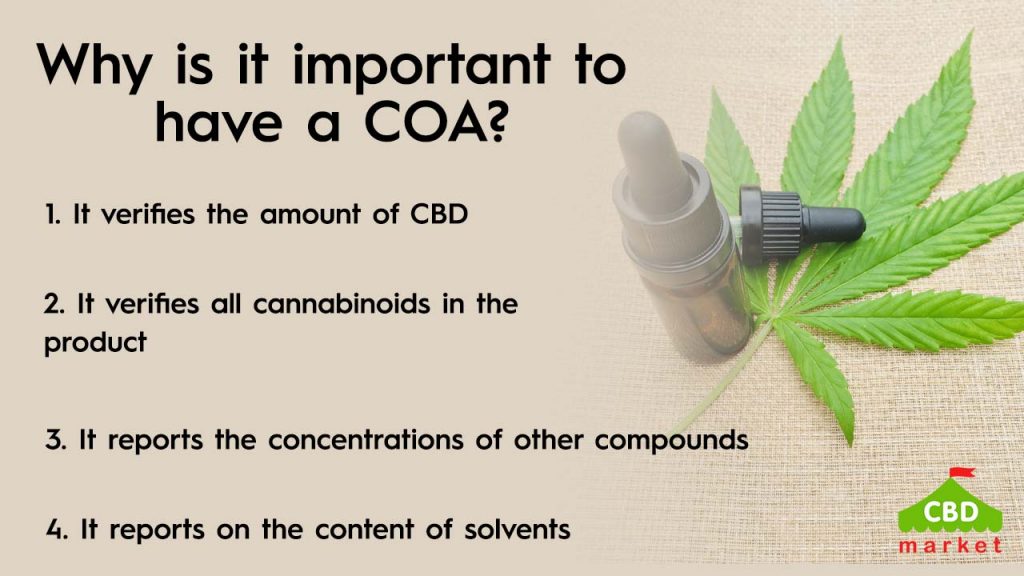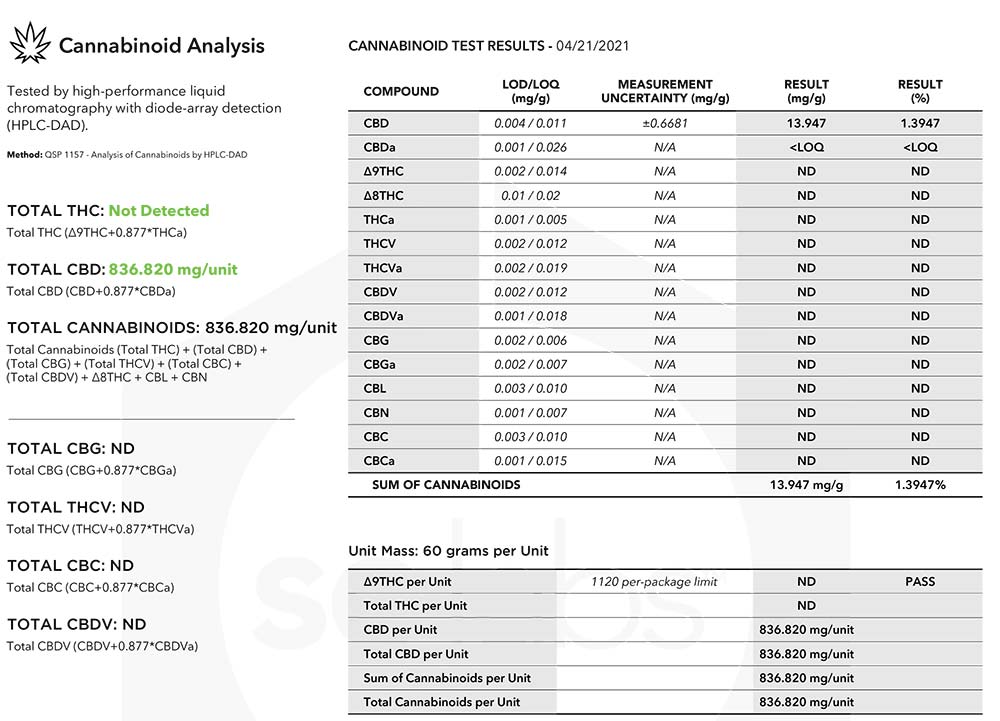How to Read a CBD Certificate of Analysis (COA)
Summarize
If there is one rule that applies to all CBD purchases, it is to carefully review the Certificate of Analysis (COA) for the CBD product. The COA is a valuable source of detailed information about product content, including cannabinoids and THC. Reliable and transparent CBD companies use an independent third-party lab to test their product batches and post a report of results for easy consumer access. The following sections discuss the purpose and content of the COA and offer tips for things to look for in the report.
Table of Contents
What is a COA (Certificate of Analysis)?
Any CBD product you choose should have undergone CBD testing by an independent lab. The CBD Certificate of Analysis (COA) reports the results of the testing, so you know you are getting what the label says is in the product. The legal requirement of CBD sourcing is that the CBD extracts come from industrial hemp, which has 0.3 percent or less THC. The COA verifies the content of all cannabinoids, including CBD and THC, in the final product and a host of other substances like heavy metals, pesticides, mycotoxins, and solvents, at a minimum.
The laboratories test substances for several reasons:
- The hemp plant is a phytoremediator, meaning it absorbs whatever is in the soil, like heavy metals and pesticides
- The CBD plant material is subjected to an extraction process in which some type of solvent is normally used
- Many CBD products have additional ingredients
Why is it so important to have a COA?

Grand View Research projects the global CBD market will grow 20-23 percent over the five post-COVID years (2022-2026). This indicates the tremendous interest consumers have in CBD products, but it also means there is a continued influx of new CBD companies. Not all of them are careful or honest about their products, like the CBD potency, the extraction process, and product labeling.
The reason it is so important for a company to have a COA is to help the consumer verify product content. The CBD industry is not government-regulated, so you must depend on independent lab testing. The CBD COA brings transparency to the product, so you know what you are buying and consuming.
1. COA verifies the amount of CBD and its potency
Not all of the companies are honest concerning the levels of CBD they claim the product contains. The FDA issues warning letters every year to companies after testing indicates the products do not contain the CBD that the label says they contain. The COA shows the amount of CBD and its potency.
2. It verifies all cannabinoids in the product, including THC
A study reported in the Journal of the American Medical Association found that many product labels erroneously reported cannabinoid potency, did not report all the cannabinoids in the products, and did not report that the product contained THC. There is a long list of cannabinoids needing testing that include CBD, CBN, CBG, CBC, and THC, to name a few.
3. It reports concentrations of other elements and compounds
A COA reports on the content of terpenes, microbiological content, heavy metals, mycotoxins, pesticides and foreign materials in the product.
4. COA reports the concentrations of solvents resulting from the extraction process
The CBD extraction process can lead to residual solvents in the product. The COA reports on the content of solvents like ethanol, isopropyl alcohol, methanol and propane.
Where to find the Certificate of Analysis?
Each CBD product has a batch number which is used to identify the correct COA to review. The Certificate of Analysis is found in several different ways, depending on the CBD manufacturer:
- Link to the COA is available online on the product page where the CBD products are sold; clicking the link takes you to the COA.
- Vendor website has a COA webpage where you can enter the product batch number from the product label to view the correct COA.
- QR code is on the label; scan the code to go to the COA.
- URL for the COA is printed on the label; enter the URL in your search bar and it takes you to the correct location.
How to Read a Certificate of Analysis?
Not all COAs are alike. The COA quality is easily determined by the depth of the information provided. Some COAs are very detailed, providing details like the LoD (Limit of Detection) and LoQ (Limit of Quantitation). Others take shortcuts.
The detailed COAs list results for each cannabinoid and other substances tested. LoD and LoQ are scientific terms that indicate the lowest concentration of detectability compared to an expected concentration (LoD) and the lowest concentration of detectability compared to predefined goals or allowable amounts.
Some COAs simply say Pass or ND for “non-detectable” for cannabinoids and other substances. There are three CBD spectrums that influence the information you want to make sure you review.
Most people read the results of COA test results to learn:
- Whether the amount of CBD matches the product label
- What other cannabinoids and their amounts are in the product
- Total THC detected
- Other non-cannabinoid elements and compounds detected
Note that if the LOQ column shows “less than LOQ” next to any substance, then the substance is below the allowable limit.
Following are some of the most important details to check when reading a CBD Certificate of Analysis.
- Report date to ensure these are recent results.
- Name of the CBD brand to make sure the report is for the brand on the label.
- Product description to confirm the report is for the product you wish to purchase.
- Name of the laboratory and the certifications; may have to go to the lab’s website to determine its independence status and licensing and COA certifications.
- Batch number to make sure it matches the batch number on the product label.

- Cannabinoid potencies may be presented in forms like milligrams per gram (mg/g) and percent of the cannabinoid making up the product’s content (i.e., CBD isolate product has 990.454 mg/g of CBD, which is 99.0545 percent of the product) or milligrams per serving (i.e., CBD is 57.0 mg/mL); results may be stated as mg/g or mg/ml if a liquid or oil; a percent figure is just another way to look at the concentration and is provided because people are often more comfortable understanding a percent.
- Additional cannabinoids and their amounts.

- Terpenes and their amounts.
- Pesticides, heavy metals, mycotoxins, microbiological agents and solvents and their amounts; the action limit or action level number indicates the safe amount for each analyte (substance); the measure is based on one PPM equals one mg/kg or one PPB equals one ug/kg; if the action limit is 300 mg, for example, the product is allowed to contain 300 mg of the substance for every kilogram of product weight.
If the acronym “ND” is used on the report, it means “not detectable,” so you can read down the columns of results and look for anything that was detected, like CBD and THC.
Each laboratory uses its own COA form, so the key is to understand the basics which apply to lab standards.
What are potential “red flags” in a COA?
Comparing the product label to the COA is important. There are red flags that indicate the CBD manufacturer may not be truthful.
- The label does not match the COA for the amount of CBD
- The laboratory is not independent (some companies post a COA that they prepare from inhouse testing, trying to make consumers believe there was independent lab testing)
- The laboratory is not ISO/IEC accredited or not certified by a recognized agency
- Missing cannabinoids
- The amount of THC is too high
- Less amount of terpenes than claimed by the product label
The general rule is the COA should test for CBD; heavy metals (cadmium, arsenic, lead, mercury); mycotoxins; 45 or more pesticides; 15 common solvents, like acetone, butane, ethanol, ethyl acetate, methanol, and propane; and microbial like salmonella, funguses, and molds.
Take the Time to Review the COA
Learn how to read a cannabinoid profile, and always take the time to review the CBD COA before purchasing a product. If the COA is not available online, then contact the company for a copy. Accessing COA should not be difficult if a company is transparent about its product’s content.
Sources
- https://www.eurofinsus.com/food-testing/resources/hemp-contaminant-testing/
- https://www.grandviewresearch.com/industry-analysis/cannabidiol-cbd-market
- https://www.fda.gov/news-events/public-health-focus/warning-letters-and-test-results-cannabidiol-related-products
- https://jamanetwork.com/journals/jama/article-abstract/2661569
- https://www.ncbi.nlm.nih.gov/pmc/articles/PMC2556583/
Share this post


0